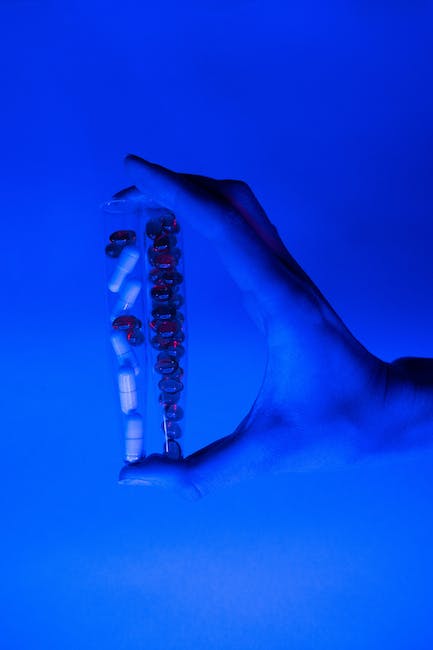Have you been struggling with dark spots on your skin? Whether it’s from sun damage, acne, or scars, you’re not alone. Many people face these common skincare concerns and are looking for effective treatments. One option that has been gaining popularity is blue light therapy. Blue light therapy is a non-invasive treatment that can help with removing sun spots, acne, and even scars that were originally caused by acne. In addition, this therapy can also treat some kinds of skin cancer and precancerous spots known as actinic keratoses.
Treating Acne and Scars
If you’ve ever dealt with acne, you know how frustrating it can be. Not only does it cause discomfort and self-consciousness, but it can also leave behind unwanted scars. Blue light therapy has shown promising results in treating acne. Studies suggest that it can improve, but not completely resolve, some cases of acne. The blue light targets the bacteria that contribute to acne breakouts, reducing inflammation and promoting healing.
Studies suggest that blue light therapy can improve, but not completely resolve, some cases of acne.
In addition to acne, blue light therapy can also help fade the scars left behind. By penetrating the skin’s surface, the blue light stimulates collagen production, which helps to plump up and smoothen the scarred areas. Over time, with regular treatments, you may notice a significant improvement in the appearance of your acne scars.
Treating Sun Spots and Actinic Keratoses
Sun spots, also known as age spots or liver spots, are a common concern as we age. These are dark, flat patches that appear on areas exposed to the sun, such as the face and hands. Blue light therapy can be effective in reducing the appearance of sun spots. The blue light targets the pigment-producing cells in the skin, breaking up the excess melanin that causes the dark spots. With consistent treatment, you may notice a lightening and fading of these sun spots.
Actinic keratoses, on the other hand, are precancerous spots that develop due to prolonged sun exposure. These reddish, scaly patches can be treated effectively with blue light therapy. A medication called aminolevulinic acid is applied to the affected area and left for about an hour. Then, the area is exposed to blue light, activating the medication and targeting the abnormal skin cells. This treatment can help to reduce the presence of actinic keratoses and lower the risk of them developing into skin cancer.
How to Incorporate Blue Light Therapy into Your Skincare Routine
If you’re interested in trying blue light therapy for your dark spots, there are a few options available. You can visit a dermatologist or aesthetician who specializes in this treatment. They will guide you through the process and recommend the most suitable treatment plan for your specific concerns.
Another option is to use at-home blue light therapy devices. These devices are designed to be safe and effective for personal use. However, it’s important to follow the instructions carefully to ensure proper usage and avoid any potential side effects.
TIP: Before incorporating any new treatment into your skincare routine, it’s always a good idea to consult with a skincare professional or dermatologist.
How to Make Blue Light Therapy Cream/Face Mask at Home
If you prefer a more natural and DIY approach, you can create a blue light therapy cream or face mask at home. Here’s a simple recipe to try:
- Mix 1 tablespoon of aloe vera gel with 1-2 drops of blue tansy essential oil.
- Apply the mixture to clean skin, focusing on the areas with dark spots.
- Leave it on for 15-20 minutes, allowing the ingredients to penetrate the skin.
- Rinse off with lukewarm water and follow with your regular skincare routine.
TIP: Blue tansy essential oil has natural anti-inflammatory properties and can help soothe the skin while targeting dark spots.
Remember, consistency is key when it comes to any skincare treatment. Whether you choose to visit a professional or try a DIY approach, be patient and give the treatment time to show results. Blue light therapy can be a valuable addition to your skincare routine, helping to fade dark spots, treat acne, and improve the overall appearance of your skin.
Give Blue Light Therapy a Try!
Now that you know about the benefits of blue light therapy for dark spots, why not give it a try? Consult with a skincare professional or dermatologist to explore your options and find the best treatment plan for your needs. Whether you choose professional treatments or create your own blue light therapy products at home, the potential for brighter, clearer skin awaits!
Discoveries in Science on Blue Light Therapy for Dark Spots
As we dive deeper into the world of blue light therapy, I’ve come across some intriguing scientific insights. It’s fascinating to see how science is continuously revealing new benefits and addressing safety concerns regarding blue light therapy for dark spots and other skin conditions.
I was especially interested in a study titled “Highlighting nuances of blue light phototherapy: Mechanisms and safety considerations” by NE Uzunbajakava and colleagues, where they tackle the somewhat mixed opinions about safety. They focus on blue light exposure within the 400–495 nm range and shed light on cutaneous disorders. Curious to learn in detail? You can check out their findings in the Wiley Online Library.
- Their research emphasized the changes in skin pigmentation that could occur after therapy, which usually isn’t intentional.
- They note that while some may find these changes undesirable, they also point out the proven clinical benefits for a range of skin disorders.
Another piece of research that caught my eye was titled “The impact of blue light and digital screens on the skin”. This study, authored by J Kumari and team, highlighted the effects of blue light therapy on conditions like Atopic Dermatitis. It was impressive to learn that there was a 54% reduction in disease severity following a 6-month therapy period. It made me think about the potential of blue light therapy not just for dark spots but for overall skin health.
These studies serve as a powerful testament to the evolving landscape of dermatological treatments, showcasing the balance between efficacy and safety.
Stay tuned as we explore even more interesting facets of blue light therapy, because trust me, the science behind it is just as fascinating as the results it promises!
“`
Please note that for an authentic web implementation, the `target=”_blank”` attribute in the `a` tags would open the links in a new tab/window. However, in certain contexts, this might not be recommended due to accessibility best practices. It has been included here for demonstration purposes assuming the platform where the blog is hosted prefers such functionality.
Answering your Questions on Blue Light Therapy for Dark Spots
Does blue light therapy remove brown spots?
Yes, blue light therapy can help remove brown spots on the skin. Blue light is an effective treatment for UV-related sun-damaged skin, including brown spots caused by sun exposure.
Does blue light get rid of spots?
Yes, blue light helps to get rid of spots. It has been shown through research that twice-weekly application of blue light therapy reduces the number of acne lesions. Furthermore, daily application of blue light therapy is even more effective in treating acne. Studies have found that blue light therapy can clear up acne by nearly 70% after 8 to 10 treatment sessions.
What are the disadvantages of blue light treatment?
The disadvantages of blue light treatment include skin sensitivity, redness, and irritation. Blue light therapy can also lead to changes in skin cells, including cell shrinkage and death.
What is the best color LED for dark spots?
The best color LED for dark spots is red. Red light therapy is known for its anti-aging benefits and can penetrate deep into the skin to stimulate collagen. Additionally, the combination of red and blue light can also provide anti-acne and anti-inflammation benefits, making it effective for treating dark spots caused by acne.
How long does it take to recover from blue light therapy?
The recovery time from blue light therapy varies depending on the individual and their specific condition. However, it typically takes about two to six weeks to fully heal after undergoing blue light therapy. During this period, some temporary side effects may occur, such as redness, swelling, and peeling of the treated area. It is important to follow post-treatment instructions provided by the healthcare professional to ensure proper healing and minimize any potential complications.
What are the pros and cons of blue light therapy?
Pros of blue light therapy include its effectiveness in treating acne, seasonal affective disorder, psoriasis, rosacea, and other skin conditions. It is a noninvasive and natural approach that does not require harsh chemicals. It also causes fewer side effects compared to other treatments.
Is blue LED light therapy beneficial?
Yes, blue LED light therapy is beneficial as it can reduce inflammation, treat skin conditions like acne and psoriasis, and potentially have anti-cancer properties. It is safe to use and has minimal risks associated with it.
Can you do blue light therapy at home?
Yes, blue light therapy can be done at home. It is an effective and convenient treatment for inflammatory acne. LED Technologies offers high-quality, FDA-cleared products for at-home use. It is recommended to complement traditional acne products with blue light therapy for additional benefits.
What are the side effects of blue light therapy for actinic keratosis?
The side effects of blue light therapy for actinic keratosis may include redness, swelling, tenderness, bruising, blistering, burning or stinging at the treatment site, as well as scaling or crusting of the skin.
What is the difference between blue light therapy and red light therapy?
The difference between blue light therapy and red light therapy is that red light therapy stimulates collagen and reduces inflammation, while blue light therapy helps treat acne by killing bacteria.
Does blue light therapy help with hyperpigmentation?
Yes, blue light therapy can help with hyperpigmentation. Blue light has been found to activate the production of melanin in the skin, leading to darkening and hyperpigmentation. However, it is important to note that this effect has been observed mainly in individuals with darker skin types (III and higher). Therefore, blue light therapy may be effective in reducing hyperpigmentation in these specific cases.
Hello, I'm Kristen Blake—a passionate advocate for radiant, youthful skin at any age. At 46, my life's work blooms from an unquenchable curiosity about the active ingredients that promise us the elixir of youth in a bottle. My days are spent immersed in the latest scientific research; every study, every breakthrough, fuels my journey.
But for me, the pursuit is more than academic. I test the wisdom of science on my own skin, embracing each wrinkle as a whispering challenge, and every age spot as a riddle to solve. As I decode the secrets of anti-aging, my experience becomes a beacon for those who seek guidance in the graceful art of growing older without losing their sparkle.
Join me as I share my discoveries and help you navigate the ever-evolving landscape of skin care. Together, we'll celebrate beauty that doesn't fade, but matures with wisdom and self-care.




